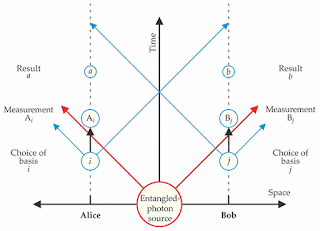Figure 2. The locality loophole arises from the possibility that hidden signals between Alice and Bob can influence the results of their measurements. This space–time diagram represents an entangled-photon experiment for which the loophole is closed. The diagonal lines denote light-speed trajectories: The paths of the entangled photons are shown in red, and the forward light cones of the measurement-basis choices are shown in blue. Note that Bob cannot receive information about Alice’s chosen basis until after his measurement is complete, and vice versa.
Citation: Phys. Today 69, 1, 14 (2016); http://dx.doi.org/10.1063/PT.3.3039
Topics: Bell's Theorem, Entanglement, Modern Physics, Quantum Mechanics, Theoretical Physics
The predictions of quantum mechanics are often difficult to reconcile with intuitions about the classical world. Whereas classical particles have well-defined positions and momenta, quantum wavefunctions give only the probability distributions of those quantities. What’s more, quantum theory posits that when two systems are entangled, a measurement on one instantly changes the wavefunction of the other, no matter how distant.
Might those counterintuitive effects be illusory? Perhaps quantum theory could be supplemented by a system of hidden variables that restore local realism, so every measurement’s outcome depends only on events in its past light cone. In a 1964 theorem John Bell showed that the question is not merely philosophical: By looking at the correlations in a series of measurements on widely separated systems, one can distinguish quantum mechanics from any local-realist theory. (See the article by Reinhold Bertlmann, Physics Today, July 2015, page 40.) Such Bell tests in the laboratory have come down on the side of quantum mechanics. But until recently, their experimental limitations have left open two important loopholes that require additional assumptions to definitively rule out local realism.
Now three groups have reported experiments that close both loopholes simultaneously. First, Ronald Hanson, Bas Hensen (both pictured in figure 1) [see link below], and their colleagues at Delft University of Technology performed a loophole-free Bell test using a novel entanglement-swapping scheme.1 More recently, two groups—one led by Sae Woo Nam and Krister Shalm of NIST,2 the other by Anton Zeilinger and Marissa Giustina of the University of Vienna3—used a more conventional setup with pairs of entangled photons generated at a central source.
Physics Today: Three groups close the loopholes in tests of Bell’s theorem
Johanna L. Miller

Comments